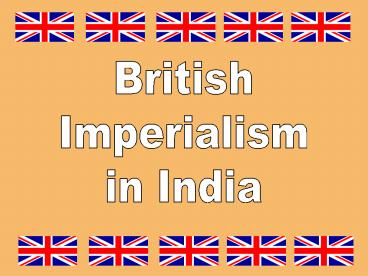British - PowerPoint PPT Presentation
1 / 28
Title:
British
Description:
... along the coasts of India, the largest being in Calcutta, Bombay and Madras. ... Clive arrived in India in 1756 as head of the Company's forces in Madras. ... – PowerPoint PPT presentation
Number of Views:700
Avg rating:3.0/5.0
Title: British
1
British Imperialism in India
2
Imperialism the policy or practice of extending
the power of a nation by formal annexation and
political rule of other areas
3
How did India become a British colony?
4
Looking back over this period, it almost seems
that the British succeeded in dominating India by
a succession of fortuitous circumstances and
lucky flukes. With remarkably little effort,
considering the glittering prize, they won a
great empire and enormous wealth which helped to
make them the leading power in the world.
Jawaharlal Nehru, The Discovery of India, 1960.
5
Merchants Lead the Way The East India Company
Established in 1600, the East India Companys
ships first reached India in 1608.
6
British
Portuguese
French
Calcutta
Bombay
Madras
Goa
Pondicherry
Gradually, the Company set up trading posts along
the coasts of India, the largest being in
Calcutta, Bombay and Madras.
7
The East India Company
Like other European companies, the East India
Company came to India in search of textiles,
spices, saltpeter, and also to use Indian ports
on their way to China where they traded in
porcelain and tea.
8
Captain John Mowbray with his Indian broker
9
Why would merchants want an empire?
For most of the 18th century, no European power
deliberately tried to establish a territorial
empire in India the Companies were organized for
trade rather than for conquest or government.
However, by 1818 the British ruled or controlled
almost all of India!
10
Why would merchants want an empire?
- They wanted to eliminate competition from other
foreign merchants. - They needed to protect themselves as the Mughal
Empire fell apart. - They discovered that politics !
11
Success! A Firman
In 1717, the Company achieved its most notable
success when it received a firman from the Mughal
Emperor exempting the Company from the payment of
custom duties in Bengal.
12
Battling the French for India
13
Siraj-ud-daulah
After fighting the French, the Company faced a
threat from Siraj-ud-daulah, the new nawab of
Calcutta. The nawab ordered all British forts in
Calcutta destroyed, and he led forces in
capturing the city in 1756.
14
Black Hole of Calcutta
Siraj captured the East India Companys main
headquarters in Calcutta, Fort William.
According to a British journalist, Siraj gave the
orders to imprison 146 English citizens in a
small airless dungeon overnight. It was reported
that 123 of the prisoners died.
15
Lord Robert Clive
Clive arrived in India in 1756 as head of the
Companys forces in Madras. He then moved to
Calcutta and managed to recapture Bengal by early
1757.
16
Battle of Plassey, 1757
1757 marks the conventionally accepted date for
the beginning of British rule in India.
17
Why did Clive win?
- Sirajs rival for the throne, Mir Jafar, sided
with Clive. - Many of the nawabs soldiers were bribed to
throw away their weapons and surrender.
18
Clive Receives the Diwan of Bengal
Diwan the right to collect tax revenues on
behalf of the Mughal Emperor
19
The British Government Steps In
When a terrible famine occurred in Bengal in
1771, killing between 3 and 5 million Indians,
the British parliament became concerned about the
Companys activities in India and passed a series
of Acts . . . .
1773 Regulating Act
1784 India Act
20
Warren Hastings, Governor-General
21
Richard Wellesley, Governor-General
22
subsidiary alliances
Indian powers "were to make no wars and to carry
on no negotiations with any other state without
the knowledge and consent of the British
Government. The greater principalities were each
to maintain a native force commanded by British
officers. The lesser principalities were to pay a
tribute to the paramount power. In return the
British Government was to protect them, one and
all, against foreign enemies of every sort.
23
expansion
Tipu Sultan
24
the resident system
25
(No Transcript)
26
(No Transcript)
27
Terms You Should Know
- Doctrine of Lapse
- Resident System
- Subsidiary Alliance
- Governor-General
- Bengal
- Diwan
- Firman
- East India Company
- Imperialism
28
Questions To Answer
- Describe the system of Subsidiary Alliances
introduced by the English East India Company's
government in India. Give an assessment, with
examples of the success of this system in the
consolidation and expansion of the British
Empire. - What were the causes of conflict between the
English East India Company and Nawab
Siraj-Ud-Daulah of Bengal? When and how did this
conflict end?































